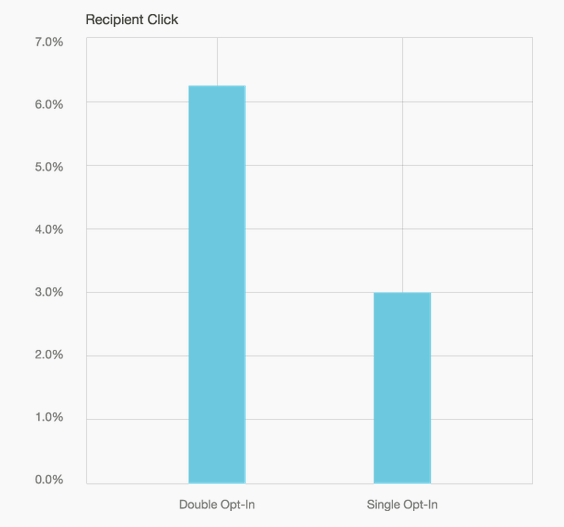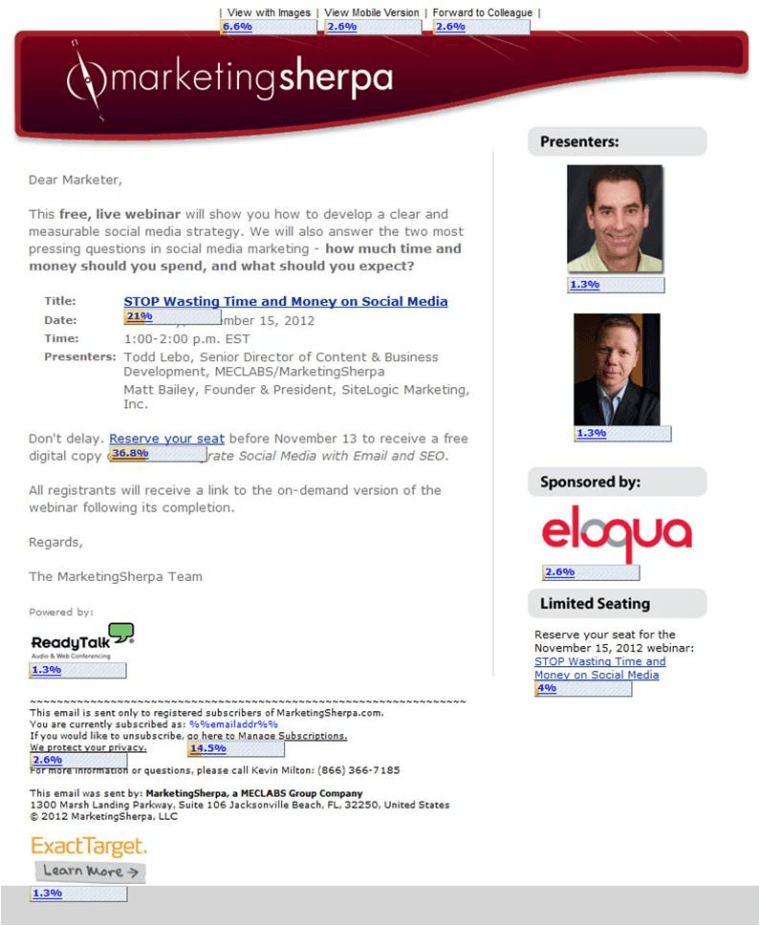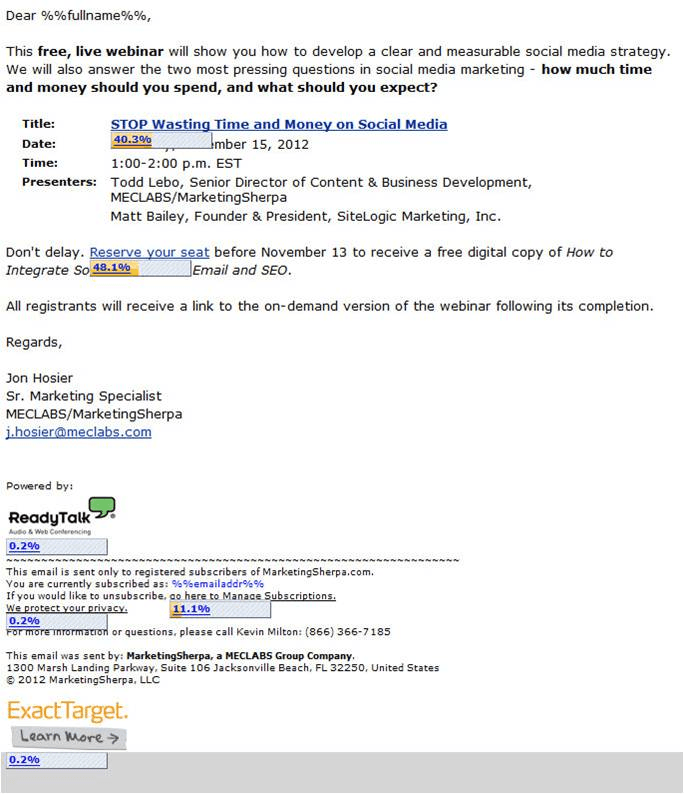You’ve composed your email’s message. You’ve formatted its design. And, finally, you’ve pressed the ‘send’ button.
So where’s all your traffic? Why aren’t people opening your message, and why aren’t those who are reading it clicking through to your website and converting?
After all, statistics suggest that 44% of email recipients made at least one purchase last year based on a promotional email, and that the average marketer earns an average return of $44.25 for every $1 spent on email marketing.
Shouldn’t your messages be performing better?
Not so fast. Despite these promising statistics, only 60% of marketers report a positive ROI from email marketing. What’s happening to the remaining 40%?
It could be any of the following mistakes:
Mistake #1: You’re Mailing From a Personal Account
Let’s just nip this one in the bud. Reputable email marketing providers charge fees to send your messages (though some, like MailChimp, offer extremely affordable or free packages for small accounts). If you’re just starting out on a tight budget, it might be tempting to think, “Forget that cost – I’ll just email my subscribers from my Gmail account.”
Not only is mailing from your personal account the height of unprofessional behavior, it will backfire. Established email providers know the ins and outs of email deliverability, meaning that messages sent from their platforms are more likely to wind up in your recipients’ inboxes than their spam folders.
After all, your subscribers can’t take action on your message if they don’t see it in the first place!
Mistake #2: You Didn’t Ask for Permission
If you’ve ever been on the receiving end of unasked for email spam yourself, you know how frustrating it can be to have the privacy of your inbox invaded by an anonymous marketer.
The solution to this problem is to move to a double opt-in protocol that requires subscribers to both request access to your list and then confirm that they did, in fact, make the request.
It’s an extra step, but data gathered by MailChimp suggests that double opted-in subscribers have a 75.6% increase in total message opens compared to single opt-in recipients, as well as a 114% increase in clicks.
Mistake #3: You’re Sending to Bad Email Addresses
Assuming you’re using a reputable email service provider, sending to bad email addresses (for example, those that subscribers have closed or abandoned), presents two different problems. First, if you’re charged by the number of people on your lists, you’re paying more every time you send a message to your inflated list.
But more importantly, sending messages to too many inactive addresses risks having your account blacklisted by the major email providers, including Google and Yahoo. Consider using a tool like Yesmail or LeadSpend to validate your lists before your next mailing.
Mistake #4: You’ve Oversold Your Message
Now, let’s get into the content of your messages. It’s tempting to try to cut through inbox clutter with a no-holds-barred subject message, like “Open for the absolute best deal ever in the history of the world!”
You can see where this is going. If the content of your message doesn’t live up to the hype of your subject line, subscribers are guaranteed to leave disappointed. According to Dan Norris, co-founder of WPCurve:
“It’s OK to encourage people to click, but if they are constantly let down when they get into your content, it will have a long-term impact. I would rather sacrifice a few clicks to maintain the integrity of my brand.”
Mistake #5: You Aren’t Personalizing Your Messages
You know when you log in to your email service provider account and see options like “[first_name_fix]” in your message drafting tools? Get good and comfortable with those features, because they could be some of the most important tools you have for improving the effectiveness of your email marketing campaigns.
Take the following two messages sent by MarketingSherpa to promote an upcoming webinar to its email subscribers:
Template Version
Personal Note Version
The first email looks prettier on first glance, but would it surprise you to learn that the personalized version experienced a 137.4% higher open rate and a 128.9% higher click-through rate?
That’s the power of personalization, and that’s why incorporating this technique into your own campaigns is an absolute must.
Mistake #6: You Aren’t Using Email List Segments
The subscribers on your list aren’t a monolith, so why are you sending them all the same message and hoping for the best?
I’m not going to belabor this point. Instead, I’m going to let data gathered by MailChimp show you how much better segmented campaigns perform, compared to their non-segmented counterparts:
Want to experience click-through rates more than 55% higher than you’re currently experiencing with your unsegmented list? Get started with these email marketing segmentation best practices from HubSpot.
Mistake #7: You Aren’t Mailing Regularly
Think of your email marketing campaigns the way you think about your exercise routine. If you don’t exercise regularly, your muscles shrink and your strength decreases. In the same way, if you aren’t mailing your subscribers regularly, you can kiss the relationship you’ve worked to cultivate good-bye.
When you mail on a regular schedule, recipients become accustomed to seeing your name in their inboxes. This familiarity breeds comfort, which may lead to more positive outcomes for your email initiatives. However, that isn’t to say you need to send multiple messages each day to maintain visibility. CrazyEgg’s suggestions on mailing frequency may offer some guidance on acceptable rates.
Mistake #8: You Don’t Have a Call-to-Action (Or You Have Too Many)
Once you’ve got your mailing frequency down, make sure every message you send out provides value for your organization by prompting recipients to take some specific action after reading. This could be anything from downloading a report to clicking through a coupon code link – what’s more important is that you include one single, well-defined call-to-action (CTA).
Few marketers get this important step right, with some forgetting the CTA altogether and others including multiple calls that compete against each other. According to Kristen Craft, director of partnerships at Wistia:
“[G]ive people a single CTA, and ideally, give them one that’s super compelling (like watching an awesome video!). A video thumbnail as your CTA is likely to give you 3x the number of click-throughs (versus any other CTA).”
Mistake #9: Your Landing Pages are Bad
Last but not least, consider that issues with your email marketing campaign may not be coming from the messages themselves, but from the landing pages you’re sending your recipients to upon clicking. If your site’s design isn’t appealing, if your offer isn’t clearly stated, or if your content isn’t helpful, there’s a good chance your conversion rates will suffer.
How can you tell if you’re facing this issue? If the metrics in your email marketing dashboard all look good, but you see a higher-than-expected bounce rate on your landing page, your website content could be at fault for your poor email performance.
Have another mistake you’ve run into that’s caused your email marketing campaigns to fail? Share the problems you have encountered and the solutions you implemented by leaving a comment below!
Image Credit
Featured Image: Unsplash.com via Pexels
All screenshots taken May 2015









![AI Overviews: We Reverse-Engineered Them So You Don't Have To [+ What You Need To Do Next]](https://www.searchenginejournal.com/wp-content/uploads/2025/04/sidebar1x-455.png)